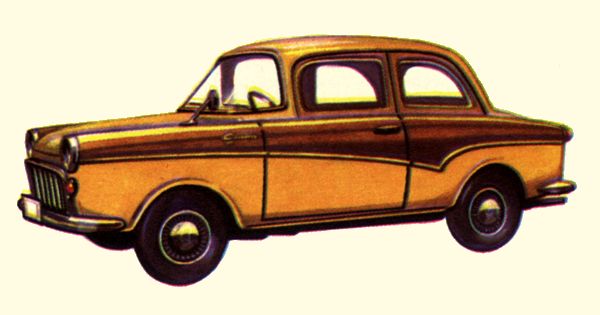Description
The Glas Isar T 600 was a small family car produced by Hans Glas GmbH between 1958 and 1965, part of the company’s move beyond microcars like the Goggomobil into more conventional automobiles. Known at first as the “Goggomobil T600,” it was quickly rebranded as the Glas Isar to give it a more serious and modern image. Positioned as an affordable, compact saloon, the Isar was Glas’s attempt to offer buyers practical transportation with a touch more space, comfort, and performance than the microcars that had made the company’s name.
The exterior design of the Isar T 600 was neat and modern for its time. A compact two-door saloon, it featured smooth, rounded lines with a simple grille, integrated headlights, and modest chrome trim. At just under 4 meters long, the car was still small by international standards, but compared to the tiny Goggomobil sedans, it looked like a proper family car. Glas also offered an estate version, known as the Isar Kombi, which added practicality for families and small businesses.
Inside, the Isar T 600 was basic but functional. The cabin could seat four adults, though rear legroom was tight. The dashboard was straightforward, typically including only the essentials: a speedometer, fuel gauge, and a few switches. Upholstery was plain but durable, reflecting the car’s budget-conscious focus. Despite its simplicity, the Isar felt a step up from the Goggomobil microcars, giving drivers the impression of a more conventional car.
Under the bonnet, the Isar T 600 was powered by a 584 cc flat-twin, four-stroke engine producing around 19 horsepower. Mounted at the rear and paired with a four-speed manual gearbox, the engine gave the car modest performance. Top speed was about 95 km/h (59 mph), enough for city and suburban driving but limited on faster roads. Fuel economy, however, was excellent, which was a key selling point in the resource-conscious environment of postwar Germany.
The Isar’s rear-engine layout gave it certain handling quirks. While the car was light and easy to maneuver, the weight distribution could lead to instability at higher speeds, a trait that limited its appeal compared to competitors like the Volkswagen Beetle. Glas made improvements over the years, but the Isar never fully overcame its reputation for being somewhat delicate and less robust than rival small cars.
Despite these drawbacks, the Isar T 600 found a market among budget-conscious buyers who wanted more
The Glas Isar T 600 was one of the most important cars in the history of Hans Glas GmbH, as it marked the company’s transition from microcars into the realm of small family cars. Produced from 1958 to 1965, it was initially marketed as the Goggomobil T600 but quickly rebranded as the Glas Isar to give it a more mature image and distinguish it from the tiny Goggomobil sedans. The Isar was aimed directly at buyers who needed a practical, affordable car with more space and refinement than the microcars that had defined Glas’s early years.
Stylistically, the Isar T 600 was clean and modern for its time. It was offered as both a two-door saloon and a more practical estate, known as the Isar Kombi. The saloon had rounded contours, a modest grille, simple integrated headlamps, and restrained chrome trim, giving it an approachable but proper family-car look. At just under four meters in length, it was still compact, but compared to the earlier Goggomobil, it looked grown-up and far more conventional.
Inside, the Isar T 600 was plain but practical. It could seat four adults, though rear legroom was limited. The dashboard was extremely simple, typically with only a speedometer, fuel gauge, and a few controls. Upholstery and trim were basic but durable, in keeping with the car’s role as a budget-friendly people’s car. Nevertheless, for many buyers upgrading from a Goggomobil or similar microcar, the Isar represented a welcome step up in comfort and space.
The Isar T 600 filled an important niche in late-1950s and early-1960s Germany. It provided an affordable, slightly larger alternative to true microcars, but it struggled against competitors like the Volkswagen Beetle, which offered greater robustness and refinement. Still, for Glas, the Isar was a bold step forward, establishing the company in the family car market and paving the way for more sophisticated models such as the Glas 1004 and 1700.
Today, the Glas Isar T 600 is a rare and fascinating classic. While overshadowed in its own time by more successful rivals, it has since become appreciated as a symbol of Glas’s ambition to move beyond microcars. Surviving examples are cherished for their charm, simplicity, and unique place in German motoring history, representing the moment when Glas tried to step into the mainstream automobile market.
